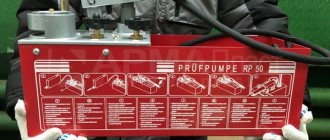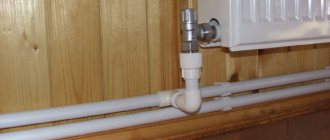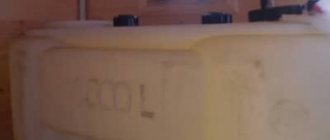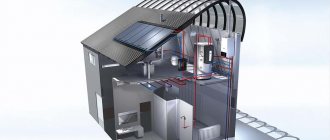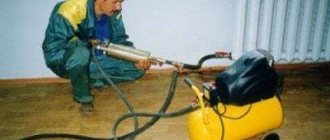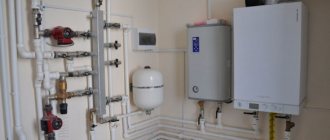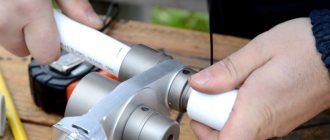In the process of heating a house or apartment, the coolant is pushed by the engine along the circuit. If it is not balanced, it will heat the rooms unevenly. For example, when the house has radiators and heated floors, one of the systems may warm up more than the other. To prevent this from happening, when installing a heating system, it is necessary that the heating system be balanced correctly.
Heating system diagram Source aw-therm.com.ua
What is the essence of balancing?
Hydraulic heating systems are rightfully considered the most complex.
Their effective operation is possible only if there is a deep understanding of physical processes hidden from visual observation. The joint operation of all devices should ensure that the maximum amount of heat is absorbed by the coolant and distributed evenly across all heating devices of each circuit. The operating mode of each hydraulic system is based on the relationship of two inversely proportional quantities: hydraulic resistance and throughput. It is they who determine the coolant flow in each node and part of the system, and therefore the amount of thermal energy supplied to the radiators. In general, the calculation of flow rate for each individual radiator reflects a high degree of unevenness: the further the heating device is removed from the heating unit, the higher the influence of the hydrodynamic resistance of pipes and branches; accordingly, the coolant circulates at a lower speed.
The task of balancing a heating system is to ensure that the flow in each part of the system will have approximately the same intensity, even with temporary changes in operating modes. Careful balancing allows us to achieve a state where individual adjustment of the thermostatic heads does not significantly affect other elements of the system. At the same time, the possibility of balancing itself should be provided for at the design and installation stage, because to set up the system, both special fittings and technical data for the boiler room equipment are required. In particular, it is mandatory to install shut-off valves, commonly called throttles, on each radiator.
Adjustment methods
When balancing the heating system in a private home, you can use temperature readings or coolant flow data as a basis. Each of them has its pros and cons.
First way
The installation implies that all necessary calculations for coolant flow have been previously carried out for the project. It is necessary not only to have control valves, but also measuring devices. Here it is possible to control the volume of coolant pumped through the system and make the necessary settings if necessary.
The advantage of using this method is the high quality of heat control in various rooms. The disadvantage of this approach is the relatively high cost of installing such a system.
Second way
It is suitable in situations where no preliminary calculations were made when installing the heating system. Then the heating system is adjusted as follows. In such cases, thermometer readings are used for adjustment. At the same time, they try to make the heat consumption approximately equal for each radiator. If the battery is installed in a large room, then it is adjusted so that the heating is proportionally higher.
The simplicity of the procedure is the main advantage of the process. The disadvantages include: insufficiently precise adjustment of heat consumption, the duration of the balancing procedure.
Symptoms of problems
It’s worth saying right away that you don’t need to go to the valves just for the love of art. Many technical specialists have a favorite phrase: “If it works, don’t touch it.” It can also be applied here. If you do not notice any negative signs in the operation of the heating system, then let it operate in the current mode. If you turn the taps at random, you can, on the contrary, unbalance everything, and then you will have to correct it.
Let's look at those phenomena that are clear signs of lack of balancing:
- temperature difference in rooms. As mentioned above, if balancing is poor or completely absent, some rooms will be much colder than others. The rooms closest to the boiler will torment you with suffocating heat, and in the furthest ones you will freeze;
- One of the radiators is constantly humming. Such noise indicates a problem in the coolant flow;
- a warm floor filled with concrete screed heats the surface unevenly.
If you have just installed a new heating system, then it a priori needs balancing, regardless of the presence of any signs.
It should be noted that not every problem in the operation of the heating system is related to its balancing. On the contrary, there are cases when performing this operation is absolutely pointless:
- airiness of the system;
- leak;
- clogging;
- malfunction of the expansion tank.
All these factors can lead to uneven heating of rooms. Balancing won't help here. It is necessary to eliminate the reason why the system is malfunctioning. For example, to deal with airiness, use Mayevsky taps, which are usually installed on radiators. With their help, you can easily and quickly expel air from a place where it is not supposed to be. As soon as you deal with the airlock, the coolant current will immediately be restored. You can learn more about how to use the Mayevsky crane from the articles on our website.
As for other reasons, everything is obvious. The leak needs to be sealed (or the damaged element replaced with a new one), the blockage removed, the expansion tank repaired (as a rule, the problem is a ruptured membrane). Only after this, if problems with coolant distribution still persist, can balancing be carried out.
If you live in an apartment building, then the question of how to balance the system is not worth it. On the contrary, you shouldn’t go there with your own hands at all, since any wrong actions will negatively affect not only your apartment, but also those of your neighbors. If you notice problems with heating in such a home, then contact the management company - solving such situations is solely within their competence.
As for a private house with an autonomous heating system, some owners believe that they can simply regulate the flow of coolant in the radiators using conventional shut-off ball valves. In fact, this is not true.
That is, if you open such a tap only halfway, the volume of incoming liquid will, of course, decrease, thereby changing the temperature in the room. But problems will soon arise with the locking equipment. The ball valve is not intended for such manipulations; its life principles are simple: it needs to be either completely open or completely closed. Any half-measures worsen its performance, and then completely disable it.
Therefore, balancing must be done, as they say, wisely. And now we’ll tell you in detail how to do this.
The most popular manufacturers of thermal heads
The market offers a wide range of thermal heads of various designs. These are liquid and gas thermal heads with a built-in thermoelement; they perfectly perform the main task of regulating the temperature in rooms. They also have an attractive design and original complement to the interior of the room.
Danfoss
The Danish company produces a large range of gas condenser and liquid thermal heads. Gas thermoelements are produced in series from RA 2000 to RA 2991, also available with a remote sensor RA 2992, anti-vandal - RA 2920. The range of temperature settings for these devices is 5-26 ℃, the waiting time is a maximum of 12 minutes. There is a function to protect the coolant from freezing, the ability to limit or block changes in the set temperature scale.
Danfoss RA 2920
Liquid thermoelements from this manufacturer are produced in the following series:
- RAE;
- RAW;
- RAS-C;
- RAS-C2.
Danfoss produces a series of premium thermostats, living eco and living connect, with a backlit display and powered by AA batteries. These thermostats have settings programs that allow you to reduce the room temperature to 17 ℃ at night and during working hours.
Living connect series thermostats are often used as part of intelligent smart home systems. Both series allow you to control the thermostat from your mobile phone via Bluetooth.
Danfoss Living Eco
Oventrop
The German manufacturer positions itself on the market as a manufacturer of high-quality engineering fittings. Exclusive products from Oventrop create special accents in the room. The design and color scheme match the interior, as well as the shape and color of the elegant radiators.
The thermostat for heating batteries "Pinox" not only attracts attention with its design, but also impresses with its functionality. The thermostat is supplied with M 30 x 1.5 thread and clamp connection. It allows you to easily and accurately adjust the temperature in the building. Thanks to its one-piece design, the regulator is impervious to dirt and easy to clean. Works without a power source.
Oventrop Pinox thermostat
The "Uni SH" thermostat with liquid element and threaded connection M 30 x 1.5 is easy to operate and has a clear scale. The thermostat has a raised mark for the visually impaired. The selected setting value can be marked using a memo puck.
Oventrop Thermostat Uni SH
Heimier
Also a well-known German brand, it produces more than 12 types of thermal heads. These are mainly liquid regulators with connection type M30*1.5, M28*1.5, which is most often used in our country.
Liquid thermal head HEIMEIER D
Among them you will find different thermal heads by design:
- with remote sensor;
- with a remote control mechanism;
- anti-vandal for installation in public places.
Heimeier F thermostat with remote adjustment
Working with radiant wiring and heated floors
As mentioned above, a slightly different procedure is used for collector wiring. It is suitable for both radiators and underfloor heating - in general, for balancing the entire system connected to one node.
Setup can be done in two different ways. For the first of them, there must be rotameters on the collector. These elements are transparent flasks and are flow meters. To balance, you will need to do some calculations. The following formula is used:
The letter G in this case denotes the mass flow rate of the heated coolant that flows along the circuit. Unit of measurement - kg/h. The letter Q indicates the amount of thermal energy that must be released by the heating circuit, it is measured in W. As for Δt, this is the difference in temperature obtained at the entrance to the circuit loop and at the exit from it. The calculated value of this parameter is 10 degrees.
Thus, you can calculate how many liters of heated coolant should pass through a certain section of the circuit per minute. The required amount of heat generated can be calculated based on standard values. According to them, 100 W are needed for every square meter of area.
Let's give an example of a calculation. Let's say the area of your room is 20 m2. This means that heating it requires 2 kW of thermal energy. We substitute the resulting value into the formula above and get the following result:
On flow meters, values are indicated in l/min, so you need to convert the value by dividing the resulting figure by 60. It turns out to be approximately 2.87 l/min.
After the calculations, the balancing procedure is carried out as follows.
- Fill and pressurize the heating circuit. The heating boiler does not need to be turned on. But the circulation pump must be started.
- Close the thermostatic valves on the second part of the manifold; this is done manually using special caps.
- Now open the first valve. Adjust the rotameter that corresponds to it using the lower ring - it needs to be rotated. Thus, set a certain level of coolant flow.
- After you deal with the first group of valve + flow meter, close this valve and move on to the second pair.
- Thus, adjust each rotameter in turn. Finally, open them all and check if each device shows the coolant flow correctly.
If there are no rotameters, then the process is carried out based on the results of measuring the temperature in the loops of the circuit. The procedure in this case will be quite tedious and long.
If you need to balance not a heated floor, but radiators connected using radial wiring, then everything is done in exactly the same way. For greater confidence, you can rely on both collector rotameters and temperature measurements. We are sure that after reading today’s article you will not have any problems with balancing. Good luck!
In accordance with applicable law, the Administration disclaims any representations and warranties that may otherwise be implied and disclaims liability in relation to the Site, the Content and its use. More details: https://seberemont.ru/info/otkaz.html
Was the article helpful?
Tell your friends
Why do you carry out hydraulic adjustment of CO?
The main goal of balancing the heating system is the correct distribution of the amount of coolant to the radiators (batteries) per unit of time, directing the required amount of heat to places where there is a shortage.
For a more complete understanding of the picture, imagine that in a certain area of the CO it is divided into two circuits, each of which leads to different rooms. Since the volume of the rooms is different, the length of the contour may vary. A circuit with a longer length (or more heating devices) has more hydraulic resistance. As you know, water (coolant) always follows the path of least resistance. In other words, according to physical laws, more heat will enter a shorter circuit than distant radiators. The figure clearly shows the distribution of thermal energy in two identical systems.
We should not forget that in an untuned CO the heat generator operates at maximum, which negatively affects all structural elements.
Summarizing the above, CO balancing is carried out for:
- Uniform heating of batteries, regardless of their location in the heating system.
- Economical operation of the boiler installation.
Advice! Balancing a two-pipe heating system (carried out with preliminary hydraulic calculations), of small length (no more than 4 heating devices) is optional
.
In all other cases, for efficient and economical operation of the CO, hydraulic adjustment is necessary!
Filters
Mud filters are essential elements of modern heating systems. When installing mud filters, it is important to take into account the rules for their installation, since it is during installation that mistakes are often made. It is also important to remember to clean them from time to time. Sometimes it is enough to install one dirt filter into a closed heating system. It is installed on the section of the main line through which all the coolant passes. Such a place could be, for example, the area in front of the main circulation pump.
Basic rules for installing mud filters:
- It is preferable to install the filter on horizontal sections of the pipeline.
- When installing the filter, it is important to ensure that the direction of movement of the coolant coincides with the marks marked on the body of the device.
- The tap branch, equipped with a screen, nut (or drain cock), should be located at the bottom.
- The dirt filter must be installed in a place that is easily accessible for maintenance.
- Shut-off valves (half-turn valves) should be installed at the inlet to the filter, as well as at the outlet.
Balancing the heating system in a private house
After installation is complete, the heating system needs to be adjusted or balanced. This allows you to identify, correct, and eliminate inconsistencies in the operation of the boiler unit and other devices, ensuring high efficiency of operation and heat transfer.
Contrary to popular belief, the heating system of not only a large multi-storey building, but also a small private house, up to a small-sized country house, needs balancing. Imbalance is the cause of improper heat distribution, when some rooms are very hot and others are not warm enough.
In this regard, it is recommended to carry out balancing before the start of each heating season.
Preparatory stage
As a rule, in warm weather the heat supply structure is not used. Therefore, before starting heating in a private house, it is necessary to ensure the integrity and reliability of its elements and carry out a number of preparatory work. Before using a closed heating system, you need to determine the amount of deviation of its actual indicators from the calculated parameters.
First of all, a visual inspection of communications and heating equipment is carried out. For the property owner, the first question should not be how to put the radiator into operation. First of all, he needs to make sure that there is no mechanical damage to the device body and check the reliability of its connection to the pipeline.
Also, before starting the heating system, a number of preventive measures are carried out:
- Checking the condition of the smoke exhaust system. To start a boiler, there must be sufficient draft force in the chimney to maintain combustion. For this reason, the internal cavities are cleaned of soot and the integrity of the pipe is inspected. In a brick structure, if necessary, replace damaged elements. Rust, if any, is removed from galvanized pipes.
- Visual inspection of pipes. Without this, running the heating system is dangerous. You need to find out how tight the pipes are and whether there are any cracks or noticeable defects.
- Battery condition monitoring. Before starting heating in an apartment building, the management company must warn residents about this, and they must check the integrity of the radiators. You cannot disconnect individual devices from the heating network. When filling the pipelines, make sure there are no coolant leaks.
This is a list of rules without which the first start-up of the system should not be done. In order for the heating season to start correctly, a number of measures must be taken. A test run of the heating system in an apartment building is carried out 1–2 months before heating starts. It is best for property owners to stay home during this time to ensure there are no leaks.
Balancing Tools
These include a balancing valve and a special measuring device.
A balancing valve is a type of shut-off valve for adjusting hydraulic resistance in heating systems. The device solves the problem by changing the cross-sectional diameter of the pipe.
Modern Y-type models are distinguished by the possibility of presetting, which limits the flow rate marked on the handle with a scale. The design provides for the presence of two nipples for measuring pressure, temperature, and coolant flow differential. The name is due to the shape of the body, where the cones are placed at an optimal angle to each other. This minimizes the influence of coolant flow on measurements and increases the accuracy of adjustment.
When to install
:
- The maximum load on the system does not provide a comfortable temperature.
- Under constant load, significant temperature changes are observed in the room.
- Normal heating power cannot be achieved.
The advantages of installing this device are as follows:
:
- Reducing fuel consumption and heating costs.
- Increasing the efficiency of the heating system and increasing comfort due to the ability to regulate the air temperature in each individual room.
- Makes it easier to start.
Modern balancing valve
Installation of a balancing valve involves the use of special fittings and adapters
It is important to pay attention to the presence of an arrow stamped on the body of the device and its direction. Some devices are mounted strictly in a certain direction of water circulation. Violating this manufacturer's recommendation will cause valve failure and system failure.
Once installation is complete, measurements should be taken to determine the level of adjustment.
Violating this manufacturer's recommendation will cause valve failure and system failure. Once installation is complete, measurements should be taken to determine the level of adjustment.
Pressure and temperature differences, as well as coolant flow across the balancing valve can be measured using a special device.
The multifunctional computer device is equipped with precise sensors, and in addition to the measurement function, it is capable of eliminating detected errors and carrying out balancing. This device greatly simplifies and speeds up the process of fine-tuning the heating system.
Manufacturers of modern devices provide the ability to connect them to a computer. Installing a special program allows you to transfer data to a PC for further work with them.
It is important not only to buy modern equipment, but also to know how to use it. Otherwise, the setup process will be ineffective, which will lead to improper heating operation, lack of a comfortable microclimate, excessive consumption of thermal and electrical energy
- Using partner valves, the hydraulic system is divided into modules.
- Next, all parts are balanced, from risers and collectors to heating points. This makes it possible to achieve the design flow rates of all modules and valves with minimal pressure losses on the devices themselves.
- After balancing, the pump switches to the power that provides the calculated rate of water circulation in the system. This will allow you to adjust the flow rate on the main module located at the pump.
The result of adjusting the balancing valves is the data obtained about what values are required and achieved. This information allows you to check the quality of the work performed and is its guarantee.
Regulator with temperature control sensor for heating balancing
As a result of correctly performed balancing, the pumping equipment begins to consume a minimum of electricity, and the consumption of thermal energy is carried out rationally.
Another problem that one has to face in the absence of special devices is the inability to determine the quality of the heat supply when it is in operation. Y-type balancing valves with measuring nipples have a system self-diagnosis function, which consists of the following:
:
- Determining the malfunction while the heating system continues to operate.
- Checking the technical condition and operating parameters of equipment.
- Making decisions when identifying faults.
Thus, errors are found and quickly eliminated.
Collectors
The collector groups separate the main heating circuits, as well as individual circuits of the underfloor heating system.
This is what a heated floor manifold assembly with a three-way mixing valve looks like.
In addition to the above cases, collector units are used in radiant heating systems.
A lot of controversy arises about where to install circulation pumps in collector systems, as well as in simple heating systems - on the supply or return? Here's what experts say about this.
Evgeniy Kruchinin
By and large, it makes no difference where the circulation pump is installed - in the supply or in the return. It is important that the pump is easy to maintain - this is perhaps the main criterion for choosing an installation location. An exception is the case when the temperature of the coolant in the heating system may exceed the maximum temperature for which the circulation pump is designed. In this case, it is recommended to install the pump on the return line, where the coolant temperature is lower.
Multi-circuit heating is a cumbersome engineering communication with many elements that must be correctly calculated, installed and combined into a single system.
In order to make the piping scheme simpler, more reliable and aesthetically pleasing, experts recommend using pump groups (quick installation groups), which are completely ready for installation and are sold already assembled. They include circulation pumps and piping elements that may be needed in one case or another.
Pump groups can be used as part of simple and complex heating systems.
Evgeniy Kruchinin
Pumping groups are easy to install and operate. All strapping elements included in the quick installation group have already been selected according to their characteristics and assembled into a single structure. Moreover, each pump group produced is necessarily tested by pressure testing at the factory, which makes it a much more reliable solution than pump piping assembled “from scratch” from the market. This greatly simplifies life for both installers and residents. In addition, compact pumping groups, having an aesthetic appearance, fit perfectly into the interior of a modern boiler room.
What homeowners need to know about balancing heating systems
At first glance, it seems that there is nothing complicated in setting it up. The temperature in the rooms can be adjusted without special measuring instruments, independently, guided by subjective sensations: make it warmer in some places, cooler in others. But often the result does not live up to expectations, since the average user does not take into account the laws of hydraulics: an increase in the flow area of the balancing valve of one radiator will lead to a decrease in flow on another radiator
And here it is important to catch that same balance
“In an unbalanced heating system, in order to warm all the rooms in the house, the circulation pump has to work with increased load, which accelerates its wear and sometimes causes noise in the pipes. In such cases, you will have to forget about thermal comfort, as well as savings, says Maxim Nemkov, head of the installation department, which provides services for the design, installation and maintenance of utility networks. — As practice shows, it is undesirable to install a heating system yourself - the likelihood of errors is too high. These, for example, include the selection of boilers and pumps with unreasonable reserves due to the unaccounted heat capacity of the rooms. Professionals do not allow such inaccuracies in their work.”
To minimize risks, the homeowner must have the necessary information and constantly monitor the work of the installers. So, if the master assures that designing the heating system and setting up the equipment in accordance with the engineer’s calculations is quite enough, then it is better to contact another company. Real conditions always differ from theoretical ones: for example, methods for calculating heat losses do not take into account the specific features of the building, which results in deviations of the required coolant temperature from the design values. This is an ordinary situation, but if left unattended, the system will not work correctly.
The balancing itself can be done in two ways. “Classic” implies the presence of a heating system design, according to which, by tightening the balancing valves, the required design flow through each radiator is adjusted. But having a project completed without errors is not a common occurrence these days. And the real system may differ from the calculated one. If there is no project documentation, they resort to the “emergency” method. In such cases, an electronic thermometer is used that measures the temperature on any surface. With its help, the same temperature at the outlet of all heating devices is adjusted through balancing valves. “The general disadvantages of existing methods include the lack of a universal approach and large time costs. On average, balancing takes about one working day, it is carried out by at least two people,” Anatoly Korsun, a professional installer, shares his experience. It is clear that such time expenditure is not profitable for a team of specialists, therefore, in an effort to work on as many objects as possible, they make ridiculous mistakes. And as a result, the balancing accuracy suffers, which eliminates the savings, for the sake of which, in fact, everything was started.
Nuances of using ball valves
Ball shut-off valves are completely unsuitable for regulating the heat balance throughout the house. In practice they have only two positions: Open and Closed. The effective cross section of the valve varies nonlinearly depending on the angle of rotation of the handle.
Such devices can only be used to completely block the flow. Adjustment requires at least a poppet valve with a worm drive.
But it is best, of course, to use Y-shaped balancing valves specially designed for this purpose with a built-in flow meter or with nipples for connecting a universal measuring device.
Required Tools
If you ask a plumbing professional what equipment is needed to perform a balancing operation, you will most likely hear about a thermal imager. It is used to determine the heating level of all elements of the heating system. But the cost of such a “machine” is quite high. There is no point in buying a device for one operation. In principle, you can try to rent it if you find it. But let's still try to make do with simpler and more accessible means.
For example, the following things will be enough for you:
- electronic contact thermometer. Necessary for measuring the heating temperature of heating equipment;
- screwdriver;
- hex key, which is used to rotate the balancing valve rod;
- paper and marker or pencil.
Ideally, you would need to stock up on the wiring diagram according to which the heating system was assembled. But often design documentation is simply missing, because the assembly was carried out according to temporary sketches and almost “on the knee”.
In this case, you will have to fill in what is missing. You need to make at least a rough sketch on paper of how all the elements of the heating system are located. On this plan it is necessary to indicate in what sequence the radiators are connected to the circuit and how far they are from the boiler room.
The second stage of preparation is washing the mud trap located at the entrance to the heating boiler. Then heat the heater to maximum power. As a rule, the coolant temperature should be approximately 80 degrees. This process does not depend on what the weather is like outside - you still need to warm it up.
Wiring of simple heating systems
A heating system can be called simple if it contains one direct circuit. A direct circuit means a line into which coolant is supplied from the boiler without changing the initial temperature. Some radiator heating systems are simple. They can be single-pipe, double-pipe or mixed. The most practical type of simple radiator heating is a two-pipe system based on a supply and return line.
And if its balancing is done correctly, such a system will ensure uniform heating of the radiators along the entire heating perimeter.
Let's consider the main elements of the system and their functions.
Expansion tank
A closed expansion tank is a tank equipped with a rubber membrane that divides the device into two parts (the lower half contains the coolant, and the upper half contains inert gas). When the temperature in the heating system increases, part of the coolant enters it, thereby smoothing out the pressure difference in the supply and return lines.
The tank can be installed in close proximity to the heating boiler. Additional shut-off valves (ball valve) installed in front of the tank entrance will make it easy to disconnect the tank from the system if there is a need to repair or replace it.
Security group
The security group consists of three elements connected in series or to one housing:
- An emergency safety valve that allows you to discharge excess coolant when the pressure in the system increases. The discharge can be placed in a transparent container (for example, a plastic bottle). This will make the device safer and will notify you that an emergency has occurred (even if no one was home).
- Automatic air vent - removes air from the coolant, which, if present in the heating system, can render it inoperative.
- Pressure gauge - allows you to visually monitor the coolant pressure in the supply line.
The safety group crashes into the supply line immediately at the outlet of the heating boiler. This is done in order to primarily protect the boiler, which has the highest temperature.
If it is possible to install protection directly on the boiler body, then this feature of the heating device should be used.
The safety group is installed strictly vertically, and it must be located above the level of the heating boiler.
There should be no shut-off valves between the safety group and the boiler. After all, if you accidentally close the tap, thereby isolating the protection from the rest of the heating, you can cause a rupture of the boiler or other elements of the system.
Evgeniy FORUMHOUSE user
Ignorance, inattention, haste, fatigue and other human factors can lead to accidents. For example, I changed the pressure gauge, but forgot to turn the tap, etc.
An additional automatic air release valve should be installed at the highest point of the system. Air will definitely enter the system during its refueling (refueling), and this device will help stabilize the operation of the system, avoid stagnation of the coolant due to air accumulation and extend the life of the circulation pump.
krim FORUMHOUSE user
We install the air vent at the top point of the system. It doesn't have to be on the security group.

